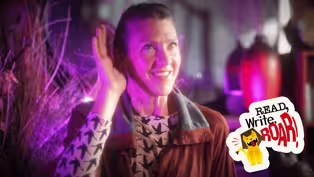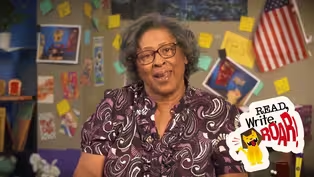Read, Write, ROAR!
Drawing Power From The Sun with Solar Power | Diagrams for Grades 4 and 5
Clip: Season 1 Episode 1017 | 6m 32sVideo has Closed Captions
Dive into our reliance on electricity and its sources.
Discover the shocking amount of electrical energy used daily. Dive into our reliance on electricity and its sources. Explore renewable and non-renewable energy, with a focus on solar power. Follow along with a detailed diagram illustrating how solar panels convert sunlight into usable electricity. Then, learn how diagrams help organize our thoughts and improve reading writing skills.
Problems playing video? | Closed Captioning Feedback
Problems playing video? | Closed Captioning Feedback
Read, Write, ROAR! is a local public television program presented by Detroit PBS
Read, Write, ROAR!
Drawing Power From The Sun with Solar Power | Diagrams for Grades 4 and 5
Clip: Season 1 Episode 1017 | 6m 32sVideo has Closed Captions
Discover the shocking amount of electrical energy used daily. Dive into our reliance on electricity and its sources. Explore renewable and non-renewable energy, with a focus on solar power. Follow along with a detailed diagram illustrating how solar panels convert sunlight into usable electricity. Then, learn how diagrams help organize our thoughts and improve reading writing skills.
Problems playing video? | Closed Captioning Feedback
How to Watch Read, Write, ROAR!
Read, Write, ROAR! is available to stream on pbs.org and the free PBS App, available on iPhone, Apple TV, Android TV, Android smartphones, Amazon Fire TV, Amazon Fire Tablet, Roku, Samsung Smart TV, and Vizio.
Providing Support for PBS.org
Learn Moreabout PBS online sponsorshipdo you know what is shocking how much electrical energy we use in just one day think about it from the alarm that wakes you up in the morning to the refrigerator that keeps the milk cold for your breakfast to the light that shines over your head we use a lot of electricity hi it's Mr Peterson and we're going to focus not just on how we rely on energy especially electricity in our lives but also examine where that electricity comes from there are many different sources of electricity but those sources are typically grouped in two categories renewable sources and non-renewable sources let's examine both renewable sources are sources that provide us with energy but are naturally renewed or replenish themselves over time two good examples of renewable energy are solar energy and wind energy non-renewable energy has the prefix of non which means not or not renewable energy examples of non-renewable energy include coal or oil we have no way to make coal or oil so once we have used them up there won't be any left this is why they are non-renewable let's take some time to examine one of the renewable forms of energy which is being used more and more more around the world solar energy or power as we learn about solar energy I'm going to make a diagram a diagram is a drawing of a structure system or process we often use diagrams to understand what we are reading if you want to follow along with me while I draw my diagram all you need is something to draw on and something to write with whatever you have will work fine solar energy starts with the Sun the sun's Rays shine down on the earth and they carry a lot of energy with them when you go outside you feel this energy as heat if you want to convert solar energy to electricity you need solar panels which are also called photo volic cells let's break that word down just a little bit photo is a prefix you might know it means light ick is the suffix and it means of or pertaining to the root word here is volt a volt is a unit of measurement for electricity so photovoltaic means pertaining to light and electricity pretty cool solar panels take the energy from the Sun and convert it into direct current electricity because solar panels need light from the sun to generate power they are typically designed to face the Sun you'll often see them on the roofs of homes but sometimes you can find them in large groups out in a field this is called a solar farm and sometimes you can find small ones on street lights or maybe even on a calculator like the one I have right here in my diagram I'm going to draw a house and on the roof I'm going to draw some solar panels then I'm going to draw some rays from the sun shining down onto the solar panels when solar panels are on the roof of the house that usually means they are generating power for the people who live there so the solar panels generate direct current electricity and feed that electricity down wires to the control box the control box converts the direct current electricity into alternating current electricity alternating current is what we need to power the devices and appliances in our homes TVs refrigerators video game systems and all of the electrical devices we plug into our Outlets are designed to run on alternating current okay I'm going to draw a box here inside the house and I'm going to draw some wires coming from the solar panels down to the control box next the control box feeds the electricity to a breaker box the breaker box contains contains Breakers which are a safety device used to stop the flow of electricity when there's a problem the breaker box contains many different Breakers and each is connected to wires in different parts of the house that end in an outlet so I'm going to draw a box right next to our control box and then I'm going to draw some wires going from the control box to the breaker box and then from the breaker box to the outlets when an appliance or an electrical device is plugged into the outlet the power flows from the outlet and the device powering it let's take a look at our full diagram photovoltaic cells convert the sun's Rays to direct current electricity the electricity flows down wires to the control box the control box converts direct current electricity to alternating current electricity the alternating current flows to the breaker box where it then flows through the breakers and to the outlets all over the house when a device is plugged in the power flows through the outlet and into the device powering it now that we created this diagram we can use it as an organizer to do a writing about how solar power works the next time you're writing about a complicated process try making a diagram what an electrifying lesson to help us with our writing [Music]
Create a Bird Soundscape | Ms. Audra | Read, Write, ROAR!
Video has Closed Captions
Clip: S1 Ep1017 | 2m 18s | Use your imagination to explore bird sounds and movements. (2m 18s)
Decoding Words! RENEWABLE | Prefixes, Suffixes, and Root Words for Multisyllabic Words
Video has Closed Captions
Clip: S1 Ep1017 | 4m 27s | Mrs. Mora teaches us how large words can be easily decoded by understanding word parts. (4m 27s)
Hydropower vs. Solar Power: Understanding Renewable Energy | LaDonna Mask | Read, Write, ROAR!
Video has Closed Captions
Clip: S1 Ep1017 | 6m 54s | Use a Venn Diagram to compare hydropower and solar power. (6m 54s)
Video has Closed Captions
Clip: S1 Ep1017 | 4m 25s | Miss Yarnell explains how kind words, clear speaking, and body language build understanding. (4m 25s)
Providing Support for PBS.org
Learn Moreabout PBS online sponsorship

- Home and How To

Hit the road in a classic car for a tour through Great Britain with two antiques experts.












Support for PBS provided by:
Read, Write, ROAR! is a local public television program presented by Detroit PBS




